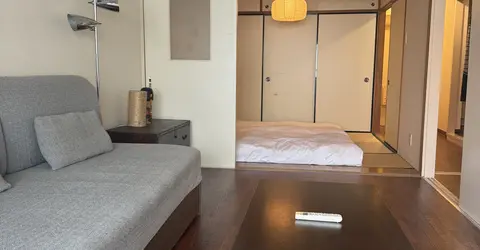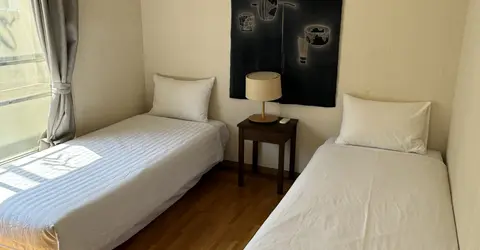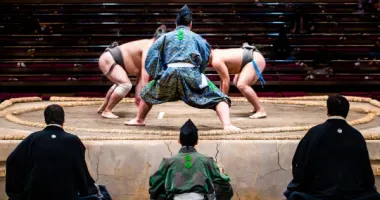Tokyo Tour Two Days In Tokyo Itinerary
Tokyo Short 2-day Tour: read a suggested guide for a short, 2-day tour of Tokyo including Tokyo museums, parks and river cruises.
Two Days In Tokyo Itinerary 東京
Kate Jones

Most guide books assume that people who come to Japan come for a longish stay, but increasingly it can also be a stopover between Europe and Australia or New Zealand, or even the Pacific islands.
As a result some people spend two or three days in Tokyo. This, however, can be a mixed blessing. Tokyo, for all its fabulous qualities, is not immediately accessible to the tourist. Tokyo is big, confusing, and it has no obvious centre.
In Paris or London or Beijing you can pick out the tourist must-dos and go there. In Tokyo it's a bit more complicated; just covering the 60 km into the city from Narita Airport involves a choice between JR express service to Tokyo Station, the Keisei Skyliner to Ueno Station or the Friendly Airport Limousine to a variety of hotels.
So for the stop-over traveller, a boutique Tokyo experience, one that doesn't involve trying to see all the highlights, might be a better choice. What follows are some suggestions for expeditions that provide a flavour of one of the most fascinating cities in the world and will be relatively easy for anyone staying centrally. Just as importantly, they won't tax that tired, jet-lagged body and brain.
Ueno
One of the possible ways to get into Tokyo from Narita, the Keisei Skyliner train, takes you directly to Ueno, in the northern part of central Tokyo. Ueno Park is full of museums and art galleries - the Tokyo National Museum, the National Museum of Western Art - as well as shrines, temples and a zoo.
At cherry blossom time it's even fuller of people than usual as crowds gather to view the blossom and to picnic under them. One of the most fascinating places to visit is the Shitamachi Museum, which is about the old downtown Tokyo working class lifestyle. It's at the southern end of the park near Shinobazu Pond with its lotus plants and bordering cherry trees. As with everywhere in Tokyo, there are numerous ways of getting there, but the easiest are by taking the JR Yamanote loop around Tokyo or the Ginza subway line (the oldest in Tokyo) to Ueno JR Station.
 Sensoji Temple, Asakasa, Tokyo
Sensoji Temple, Asakasa, Tokyo
Ameyokocho stands in stark contrast after the relative tranquillity and high culture of Ueno Park . This is an area of markets and arcades running underneath and on both sides of the Yamanote Line between Ueno Station and Okachimachi Station (south of Ueno). You can buy almost anything there - food (exotic and staples), jewellery, cosmetics and perfume (lots of these at reduced prices), clothes, bags, shoes Apparently Ameyokocho had its origin in a post-war black market, and it still has a bustling and hustling feel. At week-ends it can be almost impossible to move amongst the crowds of bargain-hunters.
Asakusa
The Ginza Line that takes you to Ueno will also take you to Asakusa, where it terminates. Most visitors to Tokyo go there to visit the Asakusa Kannon (Sensoji Temple), Tokyo's oldest temple. The approach to the temple is along Nakamise-dori, a narrow street lined with stalls selling every sort of souvenir imaginable.
The Asakusa subway line will also (not surprisingly) take you to Asakusa but a trip on the Sumida River from Hama Rikyu Garden might be more interesting and pleasant. The Hama Rikyu Garden is located on the mouth of the Sumida River . The garden originally belonged to the shoguns who ruled Japan in the 17th to 19th centuries. Today the park is a breathtakingly beautiful oasis in the centre of Tokyo. Entrance to the Hama Rikyu Garden (located at 1-1 Hama-rikyu Teien, Chuo-ku, Tokyo, is 300 yen and the easiest way to get there is to take the Oedo Subway Line or the elevated Yurikamome Line to Shiodome Station.
 Odaiba Beach, Tokyo
Odaiba Beach, Tokyo
Alternatively, it's a short walk from Shimbashi Station, which you can reach on the Yamanote JR loop line or the Ginza or Asakusa lines. But back to the boat trip. You can pick up a boat for a 35 minute cruise along the Sumida River to Asakusa at the jetty in Hama Rikyu Garden . Details are on the Tokyo Cruise website. Alternatively, you could take the boat in the other direction and go to Hinode Pier and from there to Odaiba by boat.
Odaiba
Odaiba is essentially an artificially constructed island in the middle of Tokyo Bay. It has a fun fair, a beach, shopping and entertainment malls, several museums including the ship-shaped Museum of Maritime Science and an exhibition centre, Tokyo Big Sight. As well it has astonishing futuristic architecture such as the Fuji TV Building, palm trees and wide avenues. Odaiba is unlike anything else in Tokyo. The more conventional way to get there is by the Yurikamome elevated line that leaves from Shimbashi Station and takes you across the Rainbow Bridge, allowing great views of the Tokyo waterfront.
Staying with the modern and futuristic, the Hara Museum of Contemporary Art is a great contemporary art museum that always has something to delight or offend. It's located in an entrancing modernistic white building not far from Shinagawa Station, which is another stop on the Yamanote loop. To get there leave the station by the west or Takanawa exit, turn left and either walk for 15 minutes or take a the number 96 bus bound for Gotanda Station. Turn left just after the Hotel LaForet at the top of the hill. The Hara Museum also has a delightful caf for lunch or coffee.
Not far away from the Hara Museum is the Tokyo Metropolitan Teien Art Museum and Institute for Nature Study. These present two complementary experiences in one of Tokyo 's most expensive and chic areas. The Institute for Nature Study is a wild area in the midst of the city. A branch of the Natural Science Museum, the park covers 200,000 square metres and preserves various original habitats of the Tokyo area including forest, marshes and ponds. Walking through it is like being in the heart of the country. The Tokyo Metropolitan Teien Art Museum, situated next door, is an amazing art deco building originally constructed in 1933 as the residence of a member of the Imperial Family. It is now an art museum surrounded by a spacious and tranquil garden, a complete contrast to its unruly and untamed neighbour. To get there take the Yamanote JR Line or the Namboku subway line to Meguro Station, exit by the east exit and it's a 10-minute walk straight along Meguro-dori.
 Akihabara
Akihabara
Shinjuku
The 48-story Tokyo Metropolitan Government Building could be either the first or the last stop on your two days in Tokyo, either to orientate yourself or to work out where you've been. Each tower of the building has an observation deck where most people go directly. They give an astonishing (and free) view of Tokyo.
However it is also possible to take a free tour in English, Chinese or Korean offered by the volunteer guides at the Tokyo Tourist Information Center on the 1st floor of the Tokyo Metropolitan Government No 1 Building. It covers both the Metropolitan Government Building itself and the Tokyo Metropolitan Assembly Hall.
The TMG Building is located in Shinjuku (2-8-1 Nishi Shinjuku, Shinjuku-ku), but the easiest way to get there is take the Oedo subway line to Tochomae Station; you will exit immediately outside the building. Shinjuku Station is one of the largest in the world, surrounded by a busting shopping and entertainment centre. It's fun to look around, but not to try and navigate your way through.
Tourist information is available at the arrivals level of Terminals 1 and 2 at Narita. Here you can get the essential city maps for finding your way around Tokyo. Subway stations also have English language maps, which you ask for at the information booths, and the Tokyo Tourist Information Centre has locations at the Keisei Ueno Station and Haneda Airport as well as at Shinjuku. They can direct you to the big Tokyo attractions - high style in the Ginza , electronics at Akihabara, teen fashion at Shibuya and Harajuku, and all the rest of fascinating Tokyo.
 Tokyo Tower and view of Tokyo
Tokyo Tower and view of Tokyo






























